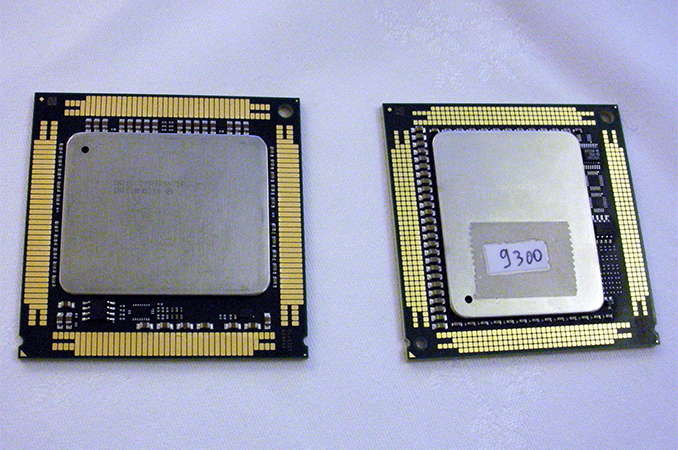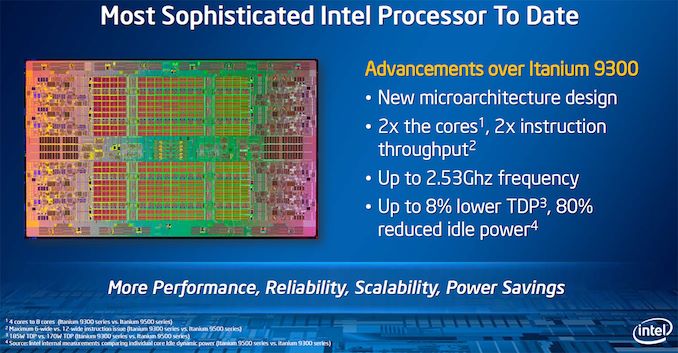Intel to Discontinue Itanium 9700 ‘Kittson’ Processor, the Last of the Itaniums
by Anton Shilov on January 31, 2019 6:30 PM EST
Intel on Thursday notified its partners and customers that it would be discontinuing its Itanium 9700-series (codenamed Kittson) processors, the last Itanium chips on the market. Under their product discontinuance plan, Intel will cease shipments of Itanium CPUs in mid-2021, or a bit over two years from now. The impact to hardware vendors should be minimal – at this point HP Enterprise is the only company still buying the chips – but it nonetheless marks the end of an era for Intel and their interesting experiment into a non-x86 VLIW-style architecture.
The current-generation octa and quad-core Itanium 9700-series processors were introduced by Intel in 2017, in the process becoming the final processors based on the IA-64 ISA. Kittson for its part was a clockspeed-enhanced version of the Itanium 9500-series ‘Poulson’ microarchitecture launched in 2012, and featured a 12 instructions per cycle issue width, 4-way Hyper-Threading, and multiple RAS capabilities not found on Xeon processors back then. It goes without saying that the writing has been on the wall for Itanium for a while now, and Intel has been preparing for an orderly wind-down for quite some time.
At this point, the only systems that actually use Itanium 9700-series CPUs are the HPE Integrity Superdome machines, which are running the HP-UX 11i v3 operating system and launched in mid-2017. So Intel's sole Itanium customer will have to submit their final Itanium orders – as well as orders for Intel’s C112/C114 scalable memory buffers – by January 30, 2020. Intel will then ship its last Itanium CPUs by July 29, 2021. HPE for its part will support their systems through at least December 31, 2025, but depending on how much stock HPE wants to keep on hand, they'll presumably stop selling them a few years sooner than that.
With the EOL plan for the Itanium 9700-series CPUs in place, it certainly means that this is the end of the road for the whole Itanium project, both for HPE and Intel. The former has been offering Xeon-based NonStop and Integrity servers for years now, whereas the latter effectively ceased development of new CPUs featuring the IA-64 ISA earlier this decade. The machines running these CPUs will of course continue their operations through at least late 2025 (or until HPE drops HP-UX 11i v3) simply because mission-critical systems are bought for the long-haul, but Intel will cease shipments of Itaniums in 2.5 years from now.
Related Reading:
- Intel to Discontinue Itanium 9500 ‘Poulson’ CPUs
- Intel’s Itanium Takes One Last Breath: Itanium 9700 Series CPUs Released
- Intel to Release New Itanium CPUs in 2012: New Architecture and Up to Eight Cores
Source: Intel











63 Comments
View All Comments
SarahKerrigan - Thursday, January 31, 2019 - link
I had front row seats for much of this long, strange saga. I miss IPF, despite its flaws - and it had many of them.mlkj - Thursday, January 31, 2019 - link
That boat sure took a long time to sink. I wonder if we'll see another big VLIW attempt in the future?boozed - Thursday, January 31, 2019 - link
The good ship Itanic finally slips below the waves.And after this boondoggle of an experiment, I doubt it!
Alexvrb - Thursday, January 31, 2019 - link
I mean if you're talking about ISAs, at the lowend something other than x86 (with x86 compatibility driven by WoA style hybrid emulation) would be possible. But for performance sensitive applications, I doubt Intel will sell anything new without an x86 frontend any time soon.mode_13h - Friday, February 1, 2019 - link
Well, you mean truly general-purpose. Because, their Xe GPU will certainly *not* use x86, nor do the chips they acquired from MobileEye, Nervana, or Movidius. Those are all performance-sensitive, but more specialized.I still think we *could* still see Intel step past x86. What'll need to happen, first, is for ARM or RISC V to displace a significant amount of their cloud/datacenter marketshare. Perhaps ARM eating their laptop market would also spur them to react.
SarahKerrigan - Thursday, January 31, 2019 - link
Itanium wasn't VLIW. It was superscalar with dependencies explicitly specified at the ISA level. In a VLIW, a bundle is an ISA atom; in Itanium, bundles were primarily a frontend distinction (you could have dependencies within a bundle) and a separate concept called "groups" existed for parallel groupings (which could span multiple bundles.)mode_13h - Friday, February 1, 2019 - link
Yeah, I think "EPIC" was specifically coined to distinguish it from VLIW. But the similarities are definitely there.Both do data dependency analysis only at compile-time. The difference is that EPIC still has runtime scheduling, while VLIW does not.
mode_13h - Friday, February 1, 2019 - link
It was more recently used GPUs and DSPs. AMD dropped it from their GPUs in 2011, with the introduction of GCN. I don't know if any mobile GPUs (still) use it, but you do still find it in DSP cores.Manch - Friday, February 1, 2019 - link
Imagination GPU's use it I think. At least they did.UtilityMax - Friday, May 24, 2019 - link
It took so long to sink because HP had no choice but continue bribing Intel to keep the IA64 processors produced. Without HP, it would have sunk a decade ago. And strangely, HP has no real strategy past 2021. They haven't ported HPUX to x86-64. Their roadmap involves "run HPUX in a virtual machine on x86-64"